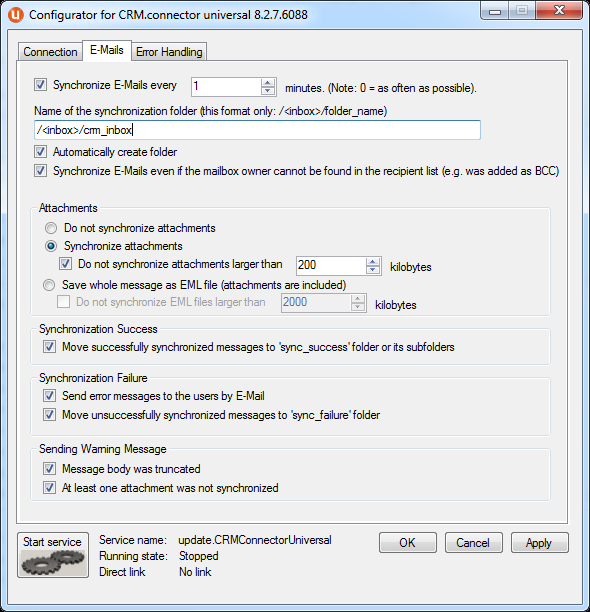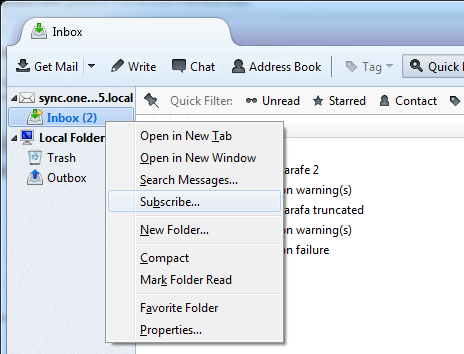E-mail Synchronization Settings
Learn how to configure the E-mail Synchronization Settings.
This topic explains the various settings you can perform on the e-mails to be synchronized. Such as the synchronization timing, attachment rules and action that can be performed in case of synchronization failure.
E-mail Synchronization Settings Dialog

Set the E-mail Synchronization Settings as per the below instructions:
Synchronize E-Mails / Synchronization Interval
Synchronize e-mails: If this check box is activated, e-mails are synchronized. De-activate the checkbox to prevent connector from synchronizing any e-mails at all.
Synchronize e-mails every n minutes: You can additionally define the interval (in minutes) in which the connector checks users' mailboxes for new mails to synchronize.
Name of the synchronization Folder and additional options
Automatically create folder: If this option is enabled, connector adds this folder to the user mailboxes if it does not already exist. If this option is unchecked, the user needs to create the synchronization folder manually.
/<inbox> is a language independent placeholder for the inbox. If you set
the parameter to /<inbox>/crm, the connector creates the CRM sub-folder
below the Inbox in an English or Posteingang in a German mailbox. As
administrator, you do not need to care about the different languages of your users'
mailboxes.E-mail Synchronization Settings Dialog

Synchronize e-mails if the owner of the mailbox cannot be found in the recipients' list (e.g. was added as BCC): If this option is enabled the owner of a mailbox is added to the recipient list exchanged between connector and CRM.interface to allow for synchronization of such e-mails.
"Attachments" Settings
Do not synchronize attachments: Enable this option to prevent attachments from being synchronized.
Synchronize attachments: If you enable this option, every attachment is synchronized as a single document and linked to the appointment (MA) record in the CRM system. You can also limit the size of the attachments via the "Do not synchronize attachments larger then <n> kilobytes setting".
Save whole message as EML file (attachments included): If enabled, the message itself including all attachments is linked to the appointment (MA) record in the CRM system as a document. You can also limit the size of the EML file via the "Do not synchronize EML files larger then <n>kilobytes setting".
"Synchronization Success" Setting
Move successfully synchronized e-mails to the following sub-folder: If this option is enabled, e-mails which have been successfully synchronized with Aurea.CRM are moved to the sync_success folder or the matching sub-folder.
sync_success folder is always a direct sub-folder of the synchronization
folder.</inbox>/crm/company1
sub-folder is synchronized with Aurea.CRM it is moved to the
</inbox>/sync_success/crm/company1 sub-folder. The particular sub-folders (in our example the company1 folder below
</inbox>/sync_success/crm/) are generated automatically.
"Synchronization Failure" Settings
mmSyncStatus property) and does not send another error message unless
the error reason changes, but in a scenario where connector is not able to access the
mmSyncStatus property (e.g. if decoding of e-mail fails), it keeps sending error
messages over and over.Sync_Failure sub-folder of the synchronization folder. - The
Sync_Failurefolder is always a direct sub-folder of the synchronization folder. - In contrast to successfully synchronized e-mails connector doesn’t create subfolders
in the
Sync_Failurefolder.
/<inbox>/crm as the synchronization folder
connector, creates a folder /<inbox>/crm/Sync_Failure and moves
unsuccessfully synchronized e-mails into this folder. connector then no longer tries to
synchronize these e-mails.